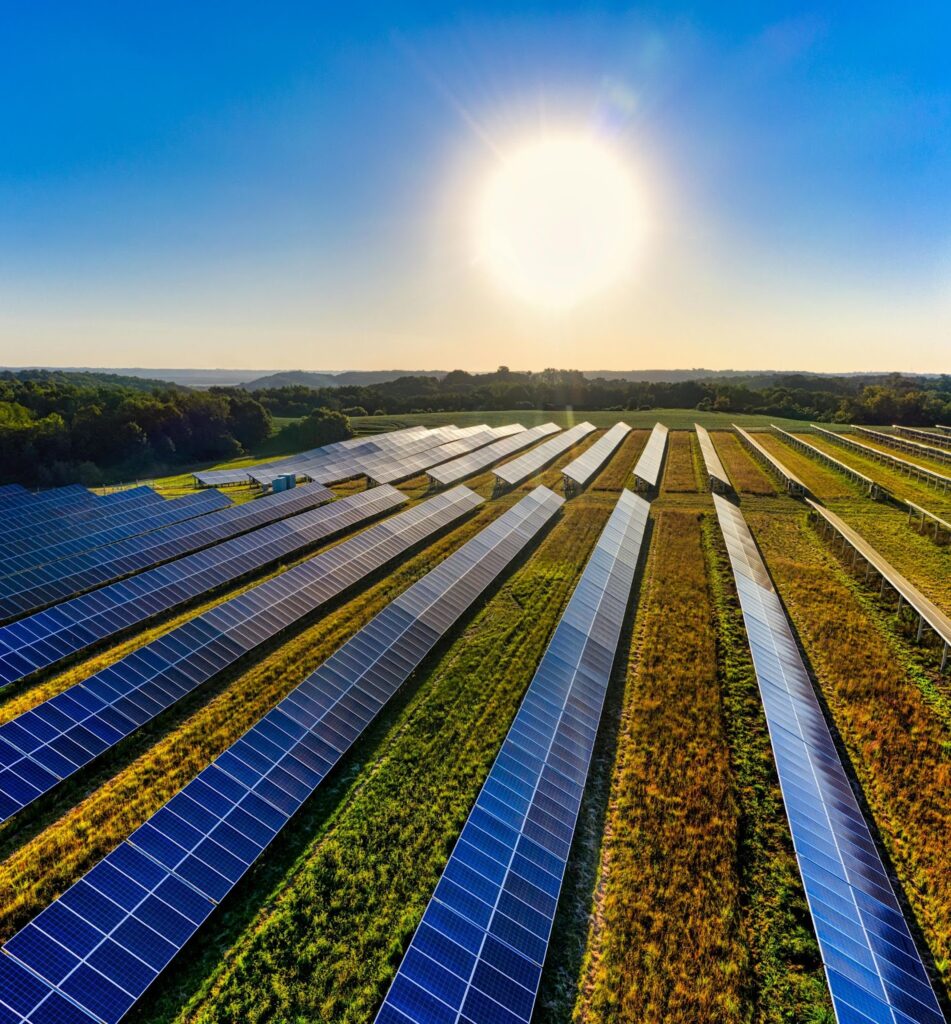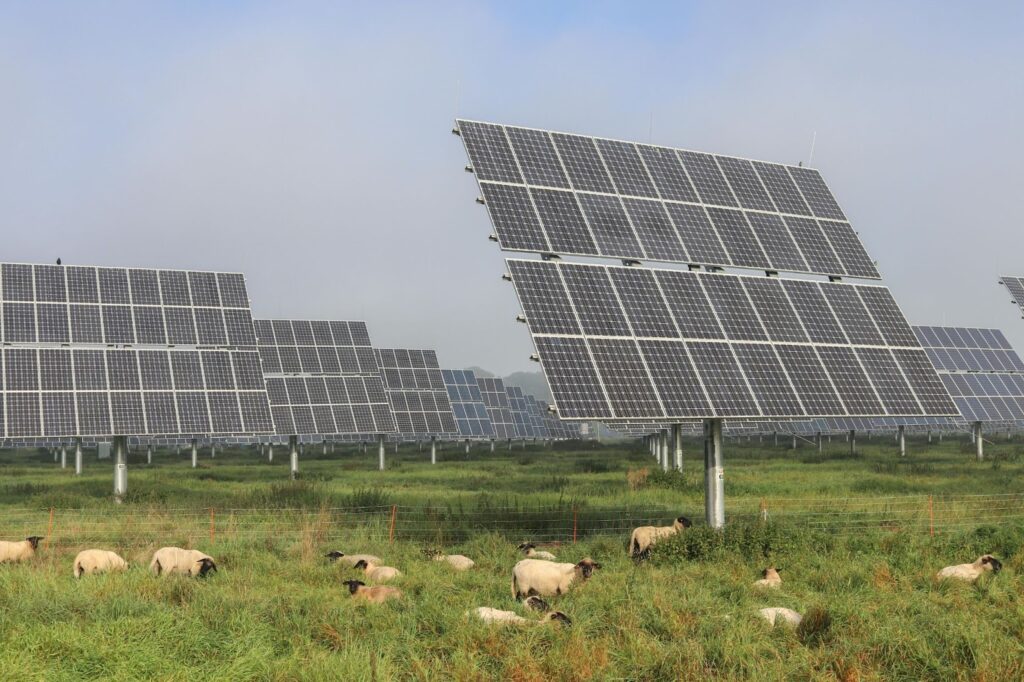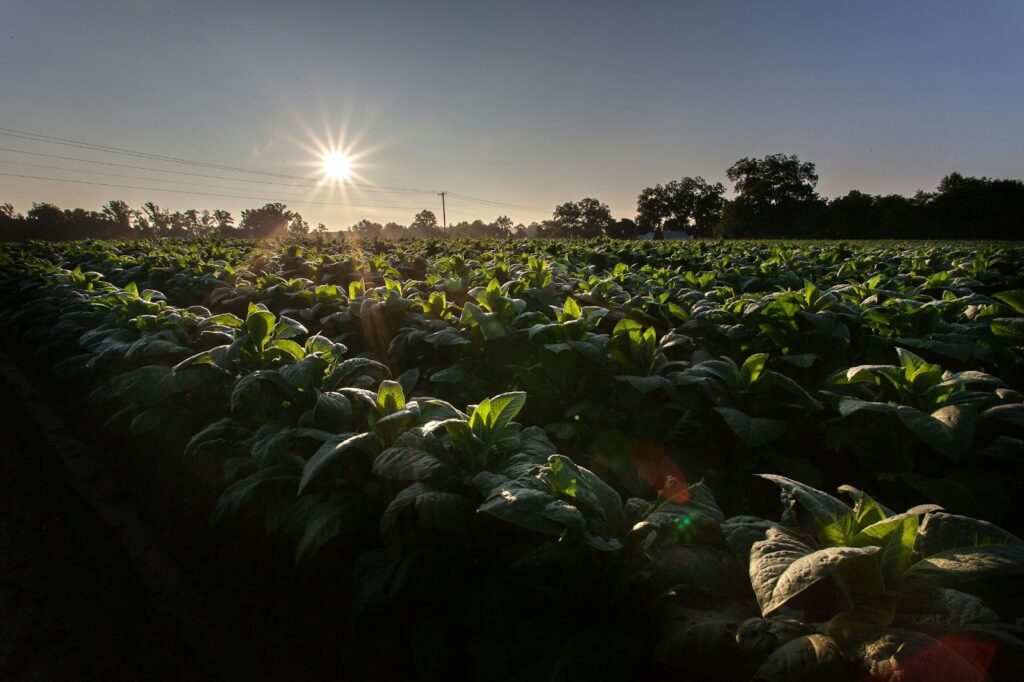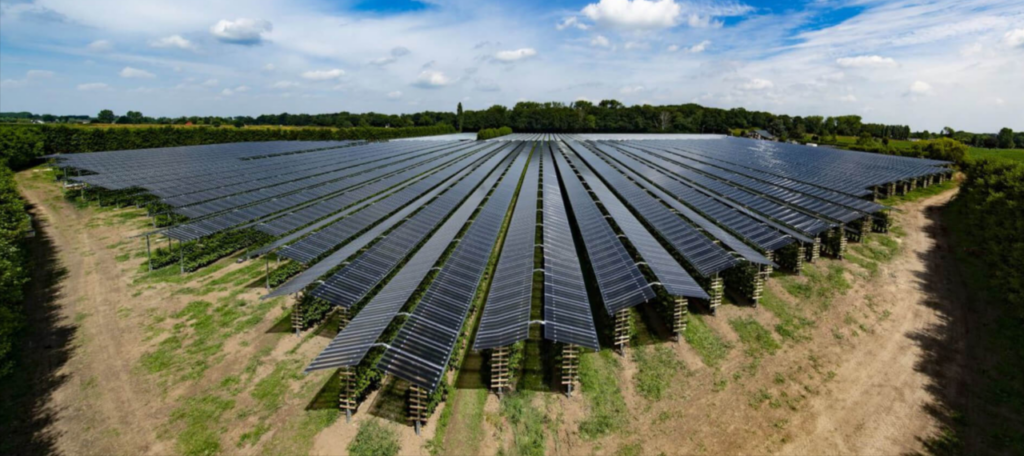
Agrivoltaics is the new buzzword among farmers and solar developers and for a good reason.
The practice neatly addresses the concern around giving up farmland in favor of solar panels and provides agricultural businesses with the opportunity to generate a dual income from the same piece of land.
Even though agrivoltaics has been successfully practiced in Europe and Asia for the past few decades, many remain skeptical and doubt whether healthy crops can be grown in the shade of a solar panel.
The truth is that many crops thrive in a more shaded environment, and the unique microclimate generated by the solar panels provides the ideal circumstances for healthy crop growth.
In this article, we’ll dig a little deeper and discover exactly what types of crops can and are being successfully grown in an agrivoltaics setup.
In a Nutshell
- Agrivoltaics refers to any type of farming or crop cultivation that occurs underneath or around solar panels.
- Crops can thrive under solar panels since they protect from the harsh sun.
- Solar panels also protect crops from cold weather and create a favorable microclimate beneath them.
- To achieve success with agrivoltaics, careful consideration for solar panel placement is required.
- Grapevines do very well under solar panels, which also improves the quality of the grape.
- Orchards under solar produce bountiful and healthier fruit.
- Japan has around 2,000 agrivoltaics farms growing over 120 crops, including most vegetables.
- Soft fruits benefit highly from the protection of solar panels.
- Other crops you can grow include cereals, wildflowers, and pasture grass.
A Quick Overview of Agrivoltaics

You may have arrived at this article without a clear understanding of what agrivoltaics is.
Agrivoltaics is a catch-all term that refers to any type of farming practice or crop cultivation that occurs on the same piece of land where solar panels have been installed.
This includes:
- Growing fruits and vegetables
- Cultivating cereal crops
- Developing orchards
- Grazing livestock
- Growing wildflowers for beekeeping
- Growing produce in solar greenhouses
The solar panels are arranged in a manner where people, animals, and even farm machinery can easily pass beneath or in between them.
In some newer setups, solar panels are even installed vertically to form a fence-like structure to make access even easier.
There aren’t yet many examples of agrivoltaics farms in the USA as the idea is only now catching on. However, those who have established an agrivoltaic setup are seeing fantastic results.
Over in Europe, there are plenty of great examples, most notably in France, Spain, Germany, and Italy. Solar developers are working with utility providers and farmers to create agrivoltaics farms and find out what types of solar installations work best with different crops.
It’s an exciting opportunity for US farmers to take hold of and it paves the way for a sustainable energy future without sacrificing the land required for our ever-increasing food requirements.
Can Crops Grow Under Solar Panels?

Absolutely! Crops can thrive under solar panels. In fact, the microclimate generated by the solar panels can create crops that are stronger, tastier, and healthier than crops grown with a traditional farming method.
There is a common misconception that crops require access to full sunlight throughout the day.
While it’s true that crops do need plenty of sunlight to thrive, they also benefit greatly from periods of shading. This is especially true if the crops are situated in a part of the world where it gets very sunny, dry, and hot.
Exposure to too much harsh sun can actually be detrimental to a plant’s health or cause it to die completely. Common problems associated with overexposure to the sun include:
- Sunscald, a problem that causes leaves to turn brown and crumble
- Flowers that wilt and die before pollinators have done their crucial job
- Leathery brown patches that appear on crops, like tomatoes and peppers
- Root hairs on newly transplanted plants that become damaged
Additionally, when plants are exposed to excess light, they ignite a process called “feedback de-excitation”, where the plants produce a carotenoid called “zeaxanthin.” This process protects the plant from overexposure but has a destructive effect on the plant’s overall quality and productivity.
In contrast, when shade is introduced to the area where crops are grown, this protects them from the ill effects of the sun and allows for a much healthier growing environment.
Other benefits that agrivoltaics provides include:
- Protection from cold weather, including frost, snow, and hail
- A reduction in water evaporation and an increase in soil moisture
- A reduction in water runoff
- A favorable microclimate beneath the panels – keeps crops warmer when it’s cold and cooler when it’s hot
- Increased biodiversity
- A reduction in pests and disease
How Do You Grow Crops Under Solar Panels?

You can’t just throw some seeds under a solar panel and call it done. Some careful considerations must be made before the solar panels are installed.
The key issue to address is that while the shading aspect is important, you must also ensure that enough light will continue to reach the crops. That means installing the rows of panels with sufficient distance between each one so that light can still travel to the ground.
Additionally, there must be enough room underneath the solar panels to access and maintain the crops as well as let them grow to their full height.
Common ways to tackle this are to:
- Raise the panels using stilted racking equipment, allowing full access underneath
- Mount solar panels in smaller batches on poles, allowing full access underneath and around them
- Install solar panels at their usual height but with a wider distance between the rows
- Install rows of vertically mounted solar panel fences
Each crop is different and has different needs. Therefore, you must think about what you intend to grow since this will influence the way you have your panels installed.
Once you have figured out the optimum installation method, you can start to farm the land as you normally would, although you may find that this changes for the better too.
For example, you will likely have to change your crop irrigation regime. This is because the soil under solar panels retains more moisture, so you may find that you have to water it less.
What Can You Grow Under Solar Panels?

Now, the million-dollar question!
You can grow lots of things under solar panels, so let’s look at them all, including a few real-world examples.
Grapevines

Grapes are a sensitive crop and are particularly vulnerable to the effects of climate change. In Europe, grape harvests have been severely impacted following periods of extended drought or when later-than-average frosts have destroyed the delicate buds forming on the vines.
The changing climate has already caused vineyards in Bordeaux to start their harvest ten days earlier than they did in 1980.
The effects of the weather also cause the grapes to increase the amount of sugar they contain, which, in turn, increases the alcohol content while reducing the acidity.
Numerous vineyards in Spain and France have started growing their vines under solar panels.
In Tressere, a region in Southwest France, vines successfully grow beneath a canopy of solar panels. They are suspended high off the ground on steel racking, allowing workers to tend to the vines. They also have a rotating mechanism that allows them to tilt and let more light reach the vines when they are overcast.
The panels perform a dual role. They insulate the vines and protect them from the effects of frost, and when it is blistering hot, they shield the vines from the sun’s rays. And this is all while they are harvesting enough energy to power 642 homes.
Fruit Trees

Fruit trees are another type of produce that has been severely impacted by climate change. In Calabria, Southern Italy, the local variety of citrus fruit had all but died out. However, thanks to an agrivoltaics setup, the fruit has now been fully revived.
Rows of solar panels installed 12.5ft off the ground have been placed in rows alternating with transparent plastic sheeting.
Like the grapevine example, this canopy protects the fruit from erratic frosts and the harsh Italian sun across all 100 hectares of land.
The solar panels provide enough electricity for 16,000 homes and have greatly impacted the quality of the citron. According to the orchard owner, the fruits are larger, have fewer defects, and are of a better color. Inside the rind, a higher concentration of essential oils is observed.
Best of all, solar panels have increased soil moisture so much that they have reduced manual watering needs by a massive 70%.
Over in France, Sun’Agri is carrying out similar projects with solar panels installed over cherry, apricot, and apple orchards.
Veggies

Leafy greens are very shade tolerant and actually prefer a more shaded environment. We’ve all seen how quickly lettuce can wilt, and the relentless sun can quickly cause salad crops and herbs to wither.
Vegetables that prefer the sun can suffer from too much exposure and experience some of the issues we noted earlier in the article.
Both can benefit from agrivoltaics, and there is no better place to look than Japan. Boasting almost 2,000 agrivoltaics farms, Japan produces over 120 crops grown under or next to solar panels.
This cornucopia consists of:
- Pumpkin
- Sweet Potato
- Green onion
- Asparagus
- Lettuce
- Peanuts
- Cabbage
- Horseradish
- Carrot
- Radish
- Tomato
- Chives
- Broccoli
- Peppers
- Cucumber
- Eggplant
- And much more!
One agrivoltaics farm in the Shizuoka prefecture successfully grows matcha tea leaves under solar panels, which are notoriously difficult to cultivate.
Another small-scale farm in the Chiba prefecture grows an abundance of peanuts, yams, eggplants, cucumbers, tomatoes, and cabbages underneath panels installed 10 feet off the ground using a simple mounting structure.
The panels are placed in a way that achieves around 32% shading. Enough to protect the crops but not starve them of light.
Another fantastic example can be found on home turf. Jack’s Solar Garden in Longmont, Colorado, is host to 3,276 panels that provide enough power for over 300 homes. Under the panels, you will find around 15 different crop varieties being grown, including salad greens, cooking greens, and root vegetables.
The panels have reduced watering requirements by around 50%, and the shade creates a far more comfortable and safe working environment for the people who tend the land.
Other Fruits

Besides fruit trees and grapes, agrivoltaics can provide the perfect environment to cultivate other types of fruit.
BayWa, in partnership with the Piet Albers fruit farm in Babberich, Netherlands, has created a unique way of protecting soft fruits from the ravages of hail and extreme weather.
The solar farm consists of 10,250 solar panels covering 3.3 hectares of raspberries while producing 2.67 MW of electricity (enough for 1,250 homes).
The panels are arranged in long rows above the raspberries in a pitched roof fashion. At the top of the pitch is a gap to let full sunlight through, while the panels themselves are semi-transparent and let in additional light.
Meanwhile, the raspberry crops are fully protected from the weather, frost, and harsh sunlight. The setup also makes it much harder for birds to discover and eat the fruits before they are harvested.
BayWa also has successful projects underway for farms growing redcurrants, blueberries, blackberries, and strawberries.

In another home turf example, a 4.2 MW community solar project is underway to cover a wild blueberry farm in Rockport, Maine.
10,608 bifacial solar-electric panels have been installed on metal racks that cover 12 acres of south-facing, sloped fields and will provide power for 800 homes.
The panels are raised and have a five-foot gap at the front, rising to an eight-foot gap at the rear with an eight-foot gap between each row so the blueberry bushes can grow among them.
Great care had to be taken during the installation process. Wild blueberry fields take up to ten years to establish, so it was important not to damage the crops while work was going on.
The project has only been in operation for a short while, so we look forward to seeing the first results emerge later in 2024.
Other Crops

The reality is that pretty much anything can successfully grow in the shadow of solar panels.
The introduction of vertical solar panels has opened up more possibilities since their structure makes it far easier for large farm machinery to pass by.
Some other crops worth mentioning include:
- Cereal crops: The vertical panels are especially ideal for cereal crops that require large amounts of sunlight. A project in France is currently growing wheat, barley, lentils, alfalfa, and aromatic herbs with this setup.
- Wildflowers: Essential for beekeeping and honey production, wildflowers grown among solar panels make it easy for pollinators to thrive.
- Pasture grass: Rather than growing crops, solar panels provide what’s needed to grow grass for pasture. When the animals come to graze, the shade protects them from the sun and keeps them healthy.
Conclusion

There are enough examples around the world to show that agrivoltaics not only works but can also lead to bountiful, healthier, and more profitable crops.
As climate change takes hold, farmers will need to find solutions to protect their crops and allow the food supply to continue. Agrivoltaics could just be the solution we’re all looking for.
We’re excited about the future of agrivoltaics in the USA, and we hope that more farmers will start to realize the benefits.
If you’re a farmer based in Colorado and want to talk solar, then we’d love to hear from you. At 8760 Solar, we specialize in providing high-performing solar PV systems to farms and agricultural businesses – that’s why we’re so interested in what agrivoltaics can do.
We’re also interested in helping you save money, get clean energy, and reap the benefits that solar can bring.
Text “READY” at 719 470-0254 or email us at sales@8760solar.com, and we’ll get back to you right away.
Frequently Asked Questions
What Crops Are Grown Under Solar Panels?
Shade-tolerant crops do very well under solar panels, including kale, broccoli, spinach, tomatoes, beets, lettuce, peppers, and radishes. In Europe, successful trials are underway that have also shown that wheat, barley, lentils, alfalfa, grapevines, and aromatic herbs also thrive under solar panels.
Can You Grow Things Under Solar Panels?
You can grow lots of things under solar panels! The shade generated by the panels provides protection from the harsh sun, prevents water evaporation, and retains soil moisture. This contributes to a biodiverse environment, allowing crops to flourish.
What Can You Put Under Solar Panels?
You can put whatever you want under solar panels as long as it does not affect the airflow underneath or damage the panels in any way. Farms can successfully grow crops under solar panels and use the area for grazing sheep. For successful beekeeping, wildflowers are often grown among solar panels.
What Plants Are Best for Agrivoltaic Crops?
Shade-tolerant fruits and vegetables are best for agrivoltaic crops, and there is a lot to pick from. Most leafy greens are suitable for growing under solar panels, as are vegetables such as tomatoes, beets, radishes, peppers, and more. Fruit trees, bushes, and grapevines also do very well under solar panels.
What Is Agrivoltaic Farming?
Agrivoltaic farming refers to the practice of installing solar panels on farmland and continuing to use the land for farming purposes. For example, the area under the solar panels may be used to graze livestock, grow wildflowers for honeybees, or grow shade-tolerant fruits and vegetables.
What Happens to the Ground Under Solar Panels?
The shade generated from solar panels creates a microclimate that is highly beneficial for the ground beneath them. It cools the temperature so that water evaporation lessens and soil moisture is retained. This increases the soil biodiversity and encourages growth, which ultimately leads to healthier ground matter.
